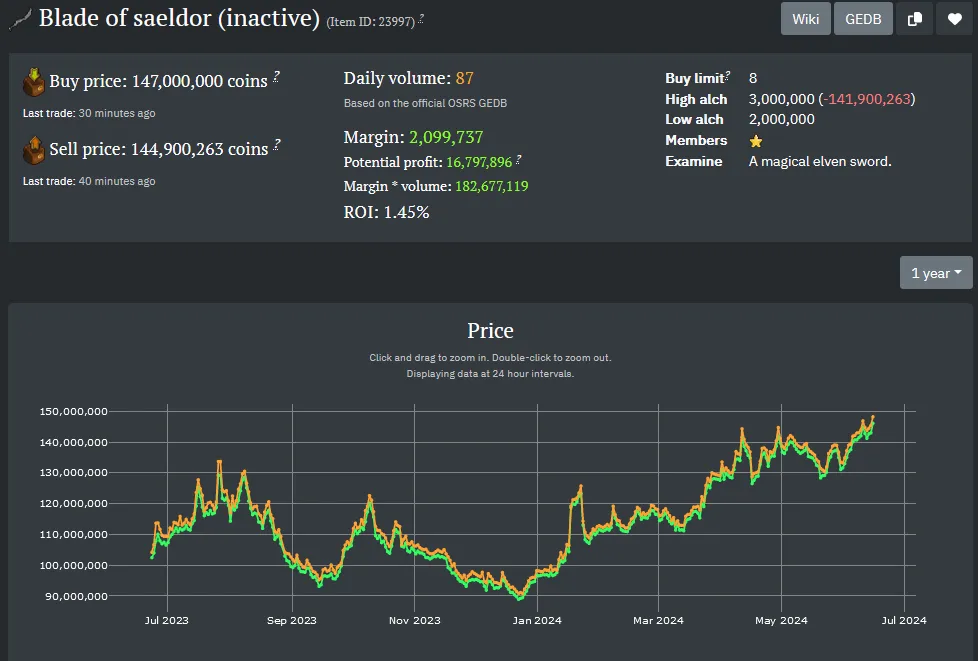Your cart is empty
Iron Bar OSRS GE: Price Trends, Uses, and Money-Making Tips

In Old School RuneScape (OSRS), the iron bar is a fundamental item for players diving into the Smithing skill or looking to make a profit on the Grand Exchange (GE). Whether you’re an ironman crafting your own gear or a trader flipping items for gold, understanding the iron bar’s role in the OSRS economy is key. This guide explores the iron bar’s price trends, uses, and strategies to maximize its value on the GE, offering practical tips for players of all levels.
An iron bar is a refined metal bar created through the Smithing skill. It’s a staple for early-game smithing and a versatile item for crafting weapons, armor, and quest items. Its accessibility makes it a popular choice for both new players and veterans looking to train skills or make gold.
How to Make an Iron Bar
To create an iron bar, you need:
- Level 15 Smithing: The minimum requirement to smelt iron ore.
- Iron ore: Mined from iron rocks at level 15 Mining or purchased on the GE.
- A furnace: Found in locations like Falador, Al Kharid, or the Blast Furnace in Keldagrim.
Smelting iron ore has a 50% success rate, meaning half the time, the ore may be too impure, yielding no bar and no experience. However, you can boost success to 100% by:
- Wearing a ring of forging (70 charges per ring).
- Using the Superheat Item spell (Magic level 43).
- Smelting at the Blast Furnace (requires starting The Giant’s Foundry).
Each successful smelt grants 12.5 Smithing XP, making it a decent early-game training method.
Why Iron Bars Matter
Iron bars are essential for crafting low-level gear like iron daggers, axes, and armor, which are useful for quests or early combat training. They’re also required in quests like The Knight’s Sword and Elemental Workshop I. For ironmen, self-sufficiency in producing iron bars is critical, while main accounts often buy them on the GE for convenience.
Iron Bar Price Trends on the Grand Exchange

The Grand Exchange is the heart of OSRS trading, and iron bars are a frequently traded item due to their utility and low cost. Let’s break down what influences their price and how to track it.
Factors Affecting Iron Bar Prices
Several factors drive the price of iron bars on the GE:
- Demand for Smithing training: Players training Smithing often buy iron bars in bulk, increasing demand.
- Bot activity: Automated accounts mining and smelting iron can flood the market, lowering prices.
- Quest requirements: Spikes in demand occur when players need iron bars for specific quests.
- Market speculation: Traders sometimes buy up iron bars to manipulate prices, though this is less common for low-value items.
Current Price and Historical Trends
As of early 2025, iron bars typically trade around 300-350 GP each, though prices fluctuate based on supply and demand. Historically, iron bars have remained stable due to their consistent use in Smithing and quests. To check real-time prices, use the GE interface in-game or third-party tools like GE Tracker, which provide live price graphs and trading volumes.
| Item | Average GE Price (GP) | Daily Volume (Approx.) |
|---|---|---|
| Iron Bar | 300-350 | 500,000+ |
| Iron Ore | 100-150 | 1,000,000+ |
Note: Prices are approximate and subject to change. Always verify in-game before trading.
Uses of Iron Bars in OSRS

Iron bars have a range of applications, from skill training to quest completion. Here’s a closer look at their primary uses.
Smithing Training
Iron bars are a go-to for early Smithing training. At level 15, you can forge items like:
- Iron dagger: 1 bar, 25 XP.
- Iron platebody: 5 bars, 125 XP.
- Iron nails: 1 bar, 10 nails, 25 XP (used in Construction).
Forging these items is slower than smelting but offers higher XP per bar. For faster training, many players smelt iron bars at the Blast Furnace, combining Mining and Smithing XP.
Quest Requirements
Iron bars are needed in several quests, including:
- The Knight’s Sword: 2 iron bars to craft a blurite sword (with blurite ore).
- Elemental Workshop I: 4 iron bars to create an elemental shield.
- Tourist Trap: 10 iron bars for a technical test (optional).
These quests make iron bars a steady demand item, especially for new accounts.
Other Uses
Beyond Smithing and quests, iron bars appear in niche activities:
- Construction: Iron nails, made from iron bars, are used for low-level furniture.
- Mahogany Homes: Iron bars are occasionally required for contracts.
- Monster drops: Some creatures, like iron dragons, drop iron bars, adding to GE supply.
Money-Making with Iron Bars on the GE
Iron bars offer several money-making opportunities, whether through production, trading, or flipping. Here are some strategies to consider.
Smelting Iron Bars for Profit
Smelting iron bars can be profitable, especially at the Blast Furnace, where the 50% failure rate is eliminated. Here’s a breakdown:
- Input: Iron ore (~100-150 GP each).
- Output: Iron bar (~300-350 GP each).
- Profit per bar: ~150-200 GP (after GE tax and ore cost).
At the Blast Furnace, players can smelt around 900-1,000 bars per hour, yielding a profit of 135,000-200,000 GP per hour. This method requires starting The Giant’s Foundry and paying a small fee for furnace access, but it’s efficient for low-level players.
Flipping Iron Bars
Flipping involves buying iron bars at a low price and selling them higher. Due to their high trading volume, iron bars are a safe item to flip for beginners. Tips for flipping:
- Check margins: Look for a buy-sell gap of at least 10-20 GP per bar.
- Use GE slots wisely: Members have 8 slots, so diversify with other items.
- Monitor trends: Buy during price dips (e.g., after bot bans reduce supply).
Flipping can yield 50,000-100,000 GP per hour with minimal effort, depending on market conditions.
Mining and Smelting for Ironmen
For ironman accounts, self-sufficiency is key. Mining iron ore at locations like the Mining Guild or East Varrock mine, then smelting at a nearby furnace, ensures a steady supply of bars. Use a ring of forging to avoid wasting ore, or train Magic to 43 for Superheat Item. This method saves GP and builds XP across multiple skills.
Tips for Trading Iron Bars on the GE
To make the most of iron bars on the GE, follow these practical tips:
Optimize Your GE Slots
Members get 8 GE slots, while free-to-play players get 3. Use them efficiently by:
- Buying in bulk: Iron bars have a 10,000 buy limit every 4 hours, so stock up during price dips.
- Selling gradually: Avoid dumping all bars at once to prevent price crashes.
- Combining with ore: Trade both iron ore and bars to hedge against price swings.
Avoid Common Mistakes
New traders often make errors that cut into profits. Steer clear of:
- Overpaying: Always check the guide price before buying.
- Ignoring noted items: Iron bars can be traded as banknotes, which confused some players in the past. Un-note them at any bank for use.
- Neglecting taxes: The GE charges a 1% tax (capped at 5M GP per sale), so factor this into your margins.
Stay Informed
Keep an eye on OSRS updates, as new content can affect iron bar demand. For example, a new quest requiring iron bars could spike prices, while a bot ban might lower them. Community forums and price trackers are great resources for staying ahead of the curve.
The iron bar may seem like a humble item, but its versatility and steady demand make it a cornerstone of the OSRS economy. Whether you’re smelting for profit, forging gear, or flipping on the GE, understanding the iron bar’s value can boost your gameplay. Start small, experiment with these strategies, and watch your gold pile grow!

